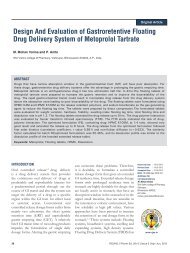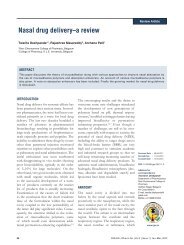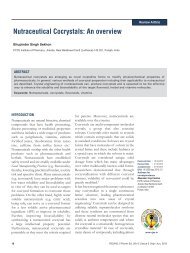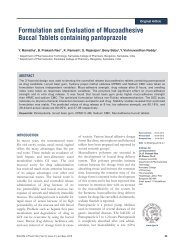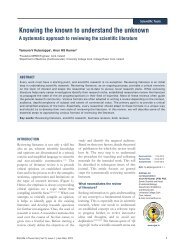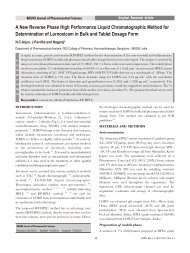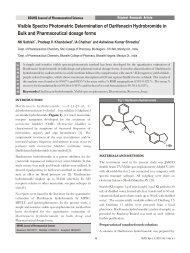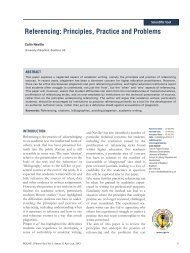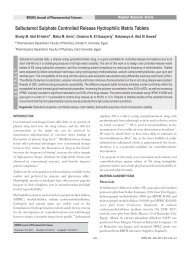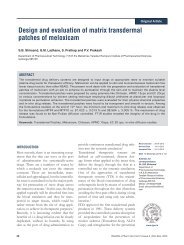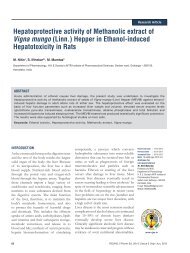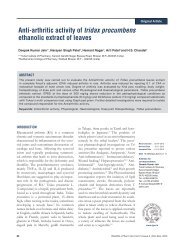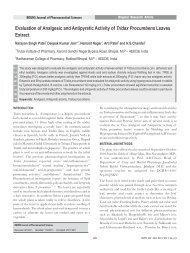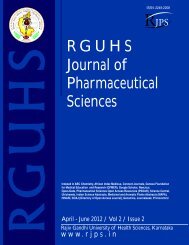Chitosan Loaded Mucoadhesive Microspheres of Gliclazide - Journal
Chitosan Loaded Mucoadhesive Microspheres of Gliclazide - Journal
Chitosan Loaded Mucoadhesive Microspheres of Gliclazide - Journal
Create successful ePaper yourself
Turn your PDF publications into a flip-book with our unique Google optimized e-Paper software.
DISCUSSION<br />
The ability <strong>of</strong> Mimosa pudica to reduce the number <strong>of</strong> animals<br />
exhibiting diarrhoea and the number <strong>of</strong> diarrhoeal episodes is<br />
12<br />
taken as an antidiarrhoeal activity . Castor oil, an irritant or<br />
stimulant laxative, is hydrolysed in the upper small intestine to<br />
ricinoleic acid, a local irritant, that irritates the mucosa <strong>of</strong> the<br />
gastrointestinal tract resulting in increase in intestinal<br />
13<br />
motility . Nitric acid mechanism has also been shown to be<br />
involved in castor oilinduced diarrhoea. The data obtained in<br />
the present study show that loperamide, a standard<br />
antidiarrhoeal agent, pr<strong>of</strong>oundly inhibited castor oil-induced<br />
diarrhoea and also inhibited in rats. Loperamide, an opioid<br />
derivative, has been shown to slow intestinal motility by its<br />
action on µ receptors on neurons in the submucosal neural<br />
plexus <strong>of</strong> the intestinal wall and its anti-muscarinic activity in<br />
13<br />
the gastrointestinal tract . It is not surprising, therefore, that<br />
loperamide protected rats against castor oil-induced<br />
diarrhoea. Mimosa pudica significantly reduced the number <strong>of</strong><br />
animals exhibiting diarrhoea and the number <strong>of</strong> diarrhoeal<br />
episodes and also inhibited the intestinal propulsion <strong>of</strong><br />
charcoal meal in the present study. It is probable that the plant<br />
extract may be exerting its antidiarrhoeal activity by slowing<br />
intestinal motility. The extract significantly inhibited the<br />
PGE 2 induced intestinal fluid accumulation (enteropooling).<br />
PGE 2 also inhibit the absorption <strong>of</strong> glucose, a major stimulus<br />
14<br />
to intestinal absorption <strong>of</strong> water and electrolytes . These<br />
observations tend to suggest that extract reduced diarrhoea by<br />
inhibiting PGE 2 induced intestinal accumulation <strong>of</strong> fluid. The<br />
extracts appear to act on all parts <strong>of</strong> intestine. Thus, it<br />
decreased the intestinal propulsive movement in charcoal<br />
meal test. The mechanism <strong>of</strong> this inhibition <strong>of</strong> motility may<br />
be due to the non-specific spasmolytic activity <strong>of</strong> the extract.<br />
Furthermore, the standard chemical tests carried out in this<br />
study showed that the leaves <strong>of</strong> the plant species contain<br />
tannins, saponins particularly steroidal saponin, and<br />
flavonoids. It is pertinent to note that tannins have been<br />
15<br />
reported in several studies to have antidiarrhoeal effect . The<br />
previous study reported that tannin containing drugs are<br />
widely used for the treatment <strong>of</strong> diarrhoea and related<br />
16<br />
disorders . In view <strong>of</strong> the above publications, it is, therefore,<br />
not surprising that the standard chemical tests in this study,<br />
showed the presence <strong>of</strong> tannins in Mimosa pudica which also<br />
may probably contribute to its antidiarrhoeal activity.<br />
CONCLUSION<br />
Md. Saifuddin Khalid et al./ Antidiarrhoeal Activity <strong>of</strong> Aqueous Extract <strong>of</strong> Mimosa Pudica Leaves<br />
On the basis <strong>of</strong> the present results and available reports, it can<br />
be concluded that the anti-diarrhoeal activity elucidated by<br />
aqueous extract <strong>of</strong> Mimosa pudica leaves could be mainly due to<br />
its inhibitory effect both on gastrointestinal propulsion and<br />
fluid secretion. The inhibitory effect <strong>of</strong> the extracts justifies<br />
the use <strong>of</strong> the plant as a non-specific anti-diarrhoeal agent in<br />
folk medicine.<br />
140<br />
ACKNOWLEDGEMENT<br />
The authors are thankful to Dr. P. G. Diwakar, joint director,<br />
botanical survey <strong>of</strong> India, Pune, for identification and<br />
authentication <strong>of</strong> plant, Dr. S.K. Srinivasan, VP (Tech),<br />
Lake chemical Pvt. Ltd., Bangalore, for gifting the<br />
Loperamide drug, Management Dr. Abdul Mujeeb,<br />
Chairman, College Governing Council, Luqman College <strong>of</strong><br />
Pharmacy, Gulbarga for providing me all facilities,<br />
throughout the research work.<br />
REFERENCES<br />
1. Farthing M J. Diarrhoea: a significantworldwide problem. International<br />
<strong>Journal</strong> <strong>of</strong> Antimicrobial Agents 2000;14: 65–9.<br />
2. Fauci AS, Bravnwold E, Isselpacker K, Wilson JD, Kasper DL, Hauser<br />
SL et al. Harrison's Principles <strong>of</strong> Internal Medicine New York: McGraw<br />
Hill Company;1993;1: 236.<br />
3. Webpage by Lynh-Diem Bui- Mimosa pudica.<br />
rd<br />
4. Nadkarni KM. Indian Materia Medica. 3 Edition 2002;1: 1280-3.<br />
5. India herbs – Ancient Remedies for Modern Times: Ayur State, Doctor<br />
approved formula for prostate care.<br />
th<br />
6. Kokate CK, Purohit AP and Gokhale SB. pharmacognosy. 14 ed.<br />
Nirali prakashan; 2007: 297.<br />
7. Khandelwal, K.R. Practical Pharmacognosy, 11th ed. Nirali<br />
Prakashan, Pune, 2004:149-56.<br />
8. Veeraraghavan, Prema. Expert Consultant, CPCSEA, OECD<br />
Guideline No.420, 2000.<br />
9. Awouters F, Niemegeers CJE, Lenaerts FM, Janssen PAJ. J <strong>of</strong> Pharm<br />
Pharmacol 1978;30: 41.<br />
10. Mukherjee PK, Das J, Balasubramanian R, Sahakakali, Pal M, Saha<br />
BP. Indian J Pharmacol 1995;27:262.<br />
11. Pazhani GP, Subramanian N, Arunchalam G, Hemalatha S,<br />
Ravichandran V. Indian Drugs 2001;38:269.<br />
12. Williamson EM, Okpako DT, Evans FJ. Pharmacological Methods in<br />
Phytotherapy Research: Selection, Preparation and Pharmacological<br />
Evaluation <strong>of</strong> Plant Material 1996; 1: 25–28.<br />
13. Altman DF. Drugs used in gastrointestinal diseases. In: Katzung, B.G.<br />
(Ed.),Basic and Clinical Pharmacology, 18th ed. McGraw-Hill, San<br />
Francisco; 2001:1070-1.<br />
14. Capasso F, Mascolo N, Izzo AA, Gaginella TS. Dissociation <strong>of</strong> castor<br />
oilinduced diarrhoea and intestinal mucosal injury in rat: effect <strong>of</strong> NGnitro-Larginine<br />
methyl ester. British J <strong>of</strong> Pharmacol 1994;113: 1127-<br />
30.<br />
15. Jaffe BM. Prostaglandins and serotonin: Nonpeptide diarrhoeogenic<br />
hormones. World J Surg 1979; 3: 565-78.<br />
Address for Correspondence<br />
Md. Saifuddin Khalid, Assistant Pr<strong>of</strong>essor, Department <strong>of</strong> Pharmacology,<br />
Luqman College <strong>of</strong> Pharmacy, Old Jewargi Road, Gulbarga-585 102,<br />
Karnataka, India.<br />
Email: khalid2568@yahoo.com



